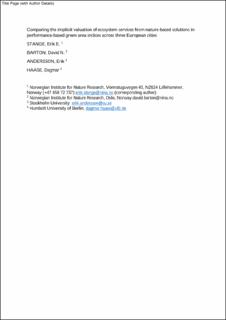Comparing the implicit valuation of ecosystem services from nature-based solutions in performance-based green area indicators across three European cities
Peer reviewed, Journal article
Accepted version

Åpne
Permanent lenke
https://hdl.handle.net/11250/2987652Utgivelsesdato
2021Metadata
Vis full innførselSamlinger
- Publikasjoner fra CRIStin - NINA [2364]
- Scientific publications [1392]
Originalversjon
10.1016/j.landurbplan.2021.104310Sammendrag
Performance-based green area indicators are increasingly used as policy instruments to promote nature-based solutions in urban property development. We explore the differences and parallels of three green area indicators: Berlin’s Biotope Area Factor (BAF), Stockholm’s Green Area Factor (GYF) and Oslo’s Blue Green Factor (BGF). As policy instruments they vary in their complexity and goals for green and blue structures. The urban planning literature devotes increasing attention to urban ecosystem services (ES) and its potential for utilitarian valuation including assigning preference weights, valuation and pricing of green and blue characteristics of urban development projects. Our comparison shows, however, that nature-based solutions in urban development projects in these three cities are largely planned, designed and implemented without using an explicit ES approach. Nevertheless, the choices of green structures and weighting of areas and structures in each city’s performance-based index constitute implicit valuation of bundles of ecosystem services. By investigating how the three indicator systems’ scores vary in parcel-scale development projects, we identify which ecosystem services each system implicitly promote and neglect. We discuss how variation in the systems’ complexity is the result of policy instrument design trade-offs between comprehensiveness and implementation costs. We argue that using physical proxies of performance in lieu of valuation of ecosystem services lowers site-specific information costs of green area indicators at property level. In the absence of an explicit ES approach, performance-based green area indicators in the three cities have been encouraging nature-based solutions in urban development without pricing of ecosystem services, without apologies. Policy design Green area points Blue-green factor Biotope factor Green space factor Ecosystem Services